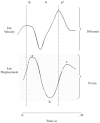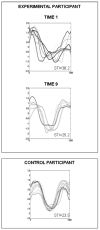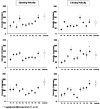The relationship between articulatory control and improved phonemic accuracy in childhood apraxia of speech: a longitudinal case study
- PMID: 20030551
- PMCID: PMC2891028
- DOI: 10.3109/02699200903329793
The relationship between articulatory control and improved phonemic accuracy in childhood apraxia of speech: a longitudinal case study
Abstract
Jaw movement patterns were examined longitudinally in a 3-year-old male with childhood apraxia of speech (CAS) and compared with a typically developing control group. The child with CAS was followed for 8 months, until he began accurately and consistently producing the bilabial phonemes /p/, /b/, and /m/. A movement tracking system was used to study jaw duration, displacement, velocity, and stability. A transcription analysis determined the percentage of phoneme errors and consistency. Results showed phoneme-specific changes which included increases in jaw velocity and stability over time, as well as decreases in duration. Kinematic parameters became more similar to patterns seen in the controls during final sessions where tokens were produced most accurately and consistently. Closing velocity and stability, however, were the only measures to fall within a 95% confidence interval established for the controls across all three target phonemes. These findings suggest that motor processes may differ between children with CAS and their typically developing peers.
Conflict of interest statement
Figures





Similar articles
-
An exploratory study of the influence of load and practice on segmental and articulatory variability in children with speech sound disorders.Clin Linguist Phon. 2017;31(5):331-350. doi: 10.1080/02699206.2016.1261184. Epub 2016 Dec 14. Clin Linguist Phon. 2017. PMID: 27960554 Free PMC article.
-
Articulatory Control in Childhood Apraxia of Speech in a Novel Word-Learning Task.J Speech Lang Hear Res. 2016 Dec 1;59(6):1253-1268. doi: 10.1044/2016_JSLHR-S-14-0261. J Speech Lang Hear Res. 2016. PMID: 27750297 Free PMC article.
-
Oral Articulatory Control in Childhood Apraxia of Speech.J Speech Lang Hear Res. 2015 Aug;58(4):1103-18. doi: 10.1044/2015_JSLHR-S-13-0221. J Speech Lang Hear Res. 2015. PMID: 25951237 Free PMC article.
-
Lexical stress in childhood apraxia of speech: acoustic and kinematic findings.Int J Speech Lang Pathol. 2020 Feb;22(1):12-23. doi: 10.1080/17549507.2019.1568571. Epub 2019 Feb 11. Int J Speech Lang Pathol. 2020. PMID: 30744428 Free PMC article.
-
Changes in movement transitions across a practice period in childhood apraxia of speech.Clin Linguist Phon. 2018;32(7):661-687. doi: 10.1080/02699206.2017.1419378. Epub 2017 Dec 27. Clin Linguist Phon. 2018. PMID: 29281317 Free PMC article.
Cited by
-
An exploratory study of the influence of load and practice on segmental and articulatory variability in children with speech sound disorders.Clin Linguist Phon. 2017;31(5):331-350. doi: 10.1080/02699206.2016.1261184. Epub 2016 Dec 14. Clin Linguist Phon. 2017. PMID: 27960554 Free PMC article.
-
Velopharyngeal Timing and Speech Sound Disorders of Unknown Etiology.Commun Disord Q. 2025 Feb;46(2):118-123. doi: 10.1177/15257401241285146. Epub 2024 Oct 8. Commun Disord Q. 2025. PMID: 40083975 Free PMC article.
-
Articulatory Control in Childhood Apraxia of Speech in a Novel Word-Learning Task.J Speech Lang Hear Res. 2016 Dec 1;59(6):1253-1268. doi: 10.1044/2016_JSLHR-S-14-0261. J Speech Lang Hear Res. 2016. PMID: 27750297 Free PMC article.
-
Exploring vowel errors produced in nonword repetition in children with speech and language disorders.Int J Lang Commun Disord. 2024 Nov-Dec;59(6):2896-2910. doi: 10.1111/1460-6984.13120. Epub 2024 Oct 4. Int J Lang Commun Disord. 2024. PMID: 39364675
-
Children and adolescents with speech sound disorders are more likely to have orofacial dysfunction and malocclusion.Clin Exp Dent Res. 2022 Oct;8(5):1130-1141. doi: 10.1002/cre2.602. Epub 2022 Jun 20. Clin Exp Dent Res. 2022. PMID: 35723352 Free PMC article.
References
-
- Allen GI, Tsukahara N. Cerebrocerebellar communication systems. Physiology Review. 1974;54:957–997. - PubMed
-
- American Speech-Language Hearing Association. Childhood Apraxia of Speech [Technical Report] 2007. [May 2009]. at: http://www.asha.org/policy.
-
- Betz SK, Stoel-Gammon C. Measuring articulatory error consistency in children with developmental apraxia of speech. Clinical Linguistics and Phonetics. 2005;19:53–66. - PubMed
-
- Bishop DVM. Motor immaturity and specific speech and language impairment: evidence for a common genetic basis. American Journal of Medical Genetics. 2002;114:56–63. - PubMed
-
- Bishop DVM, Edmundson A. Specific language impairment as a maturational lag: evidence from longitudinal data on language and motor development. Developmental Medicine and Child Neurology. 1987;29:442–459. - PubMed
Publication types
MeSH terms
Grants and funding
LinkOut - more resources
Full Text Sources
